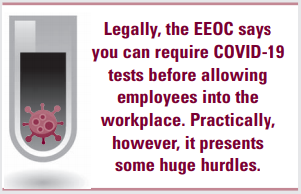Taken by panic and an abundance of caution, many organizations are considering requiring all employees to present negative COVID-19 tests as a condition to reporting to work. Legally, the EEOC says you can require this testing. Practically, however, it presents some huge hurdles.
- Tests are not a reliable indicator of whether an employee is bringing COVID-19 into the workplace because they only measure a small slice of time. Unless you are going to test every employee every day (which is not feasible or practical), a negative test only establishes that an employee does not actively have the COVID-19 virus within their system at the time the test was administered. Indeed, the CDC is not even recommending testing for COVID-positive employees any longer.
- Tests might be flawed. As Ohio’s governor recently illustrated, these tests carry a risk of false results. Indeed, a team from John Hopkins Medicine concluded that COVID-19 tests have a false negative rate of at least 20% if used too early after infection. If one in five employees who tests negative for COVID-19 is carrying the virus, why test at all?
- Tests are expensive and not available in a large enough quantity. Testing every employee every day will cost an employer a small fortune, while at the same time unnecessarily using testing resources that could be put to better use (i.e., for those who have COVID-19 symptoms). Keep in mind that the cost of testing is almost certainly on your dime if you require an employee to be tested (as per the ADA, the FFCRA, the CARES Act and various state laws). Also keep in mind that an employee’s time spent getting tested, including travel time, is almost certainly considered compensable “working time” for your nonexempt employees.
What should an employer do instead of testing employees? All employers should require employees to self-monitor for COVID-19 symptoms and, upon the presentation of any such symptoms, report to the employer and isolate per CDC guidelines. After that, the employer should contact its local department of health, do contact tracing and quarantine those who were in close contact as needed. That is the best you can hope to do to help stop this virus from spreading in your workplace.

Source: HR Specialist
Source: HR Specialist: Employment Law, September 2020 | Jon Hyman